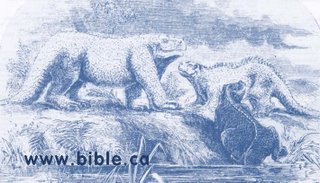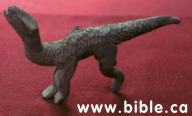Acambaro look!




Acambaro photogallery
You see here representations of Iguanadon made in 1825 (the bluish picture), again in 1895 (greenish), and another made in just the last decade. Compare them to one of the Acambaro statues made 2-3 thousand years ago or so. The Acambaro artist sculpted Iguanodon to look like he is now pictured by modern paleontologists yet it was done long before there were paleontologists!
"There was an absolutely astonishing breathless moment as one object was unwrapped and there before us a virtually perfect representation of an Iguanodon. This was one of the first dinosaur skeletons discovered. The early concept of it's appearance was almost comical in the mid 1800's. By the turn of the century it had improved considerably but fell far short of what we now know. The figurine exhibits knowledge we have gained only in the last few years. No hoaxer could have made this model in the 1940's." - Dr Dennis Swift Ph.D
TV program
"The Japanese company, Nissi, sponsored a television crew to go to Acambaro and produce a program for Japanese T.V regarding the Acambaro figurines. The program entitled "Did the Ancients See Dinosaurs" was aired on February 2, 1997 in Japan. There is a stunning moment in the program as the Japanese narrator is looking over an animal figurine, and he holds it up next to his Japanese book on dinosaurs. Amazingly, the Julsiud dinosaur figurine matches the color drawing of an Amargasaurus cazaai in the Japanese dinosaur book. The narrator quickly picks up another dinosaur figure and thumbs through the dinosaur book. This figure is very similar to the Sauraloplus osborni as drawn in the Japanese dinosaur book. The narrator ponders the perplexing problem that ancient people about 4,500 years ago must have seen dinosaurs because they could not have known what they looked like by merely seeing their skeletons in the ground. The narrator points out that when modern man found dinosaur skeletons such as Sir Richard Owen, that the life-sized models of Megalosaurus, Iquanodon and Hylaeosaurus were ridiculously inaccurate." - from the Swift report.
Dermal Spines
"The figurines he saw in the late 1940's and early 1950's were simply curious looking creatures that many years later were correctly identified as particular dinosaur species. Dr. Herrejon said that even most of the Brontosaurs looking dinosaurs did not look like a "typical" saurian dinosaur. We pressed him as to what he meant by "typical?" He replied, "they had spines all down their backs, little spines." We drew dinosaurs with conical dermal spines and Antonio pointed vigorously stating in Spanish, "That's it, That's it".
Dr. Herrejon unwittingly had helped to verify the authenticity of the Julsrud dinosaur figurines. No one knew in the 1940s, 50's, that some species of Saurian dinosaurs had dermal spines. They were perceived as represented on the Sinclair gasoline filling station signs. It was the work of Stephen Czerkas in a 1992 article that brought to light this aspect of dinosaur anatomy (Geology, V.20, No.12, 1992, p.1068-1070)." - Second Acambaro report.